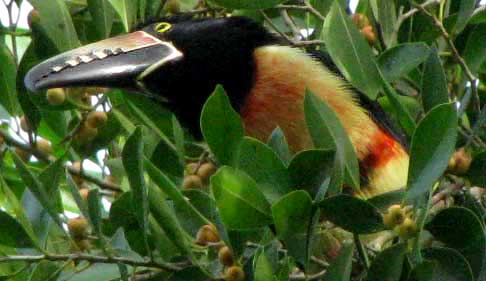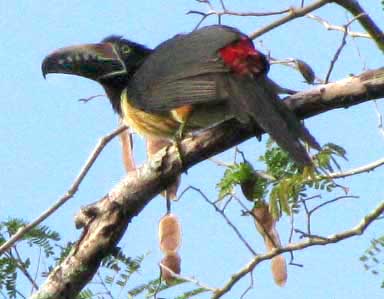Excerpts from Jim Conrad's
Naturalist Newsletter
from the February 13, 2011 Newsletter issued from Hacienda Chichen Resort beside Chichén Itzá Ruins, central Yucatán, MÉXICO; limestone bedrock, elevation ~39m (~128ft), ~N20.676°, ~W88.569°
ARAÇARI IN THE BANYAN
It was enough to make a northern birder's heart skip some beats, the way the Collard Araçari, PTEROGLOSSUS TORQUATUS, glided like a balsawood model plane into the big Chinese Banyan. He disappeared into a deeply shaded part but eventually peeped from his cover. You can see him surrounded by sweet little figs below:

I'd been trying to photograph him for weeks. During the entire first year of my being here I'd never seen a single member of the Toucan Family, to which araçaris belong. Friends had told me that not only araçaris but also Keel-billed Toucans sometimes show up here, but only after hurricanes when they get "blown up from the south." Farther south in southern Campeche and Quintana Roo there's even a third Toucan-Family member, the Emerald Toucanet, but they've never been spotted here.
Then about a month ago without even a good storm out of the south to cause it, within a week of one another not only did an araçari show up but also a Keel-billed Toucan. I heard the Keel-billed before I saw him, croaking like a very big, hoarse treefrog, RRONK-RRONK-RRONK. Who knows why these two kinds of toucan suddenly appeared here? It's true that they arrived just as the banyan's figs were beginning to ripen, but neither species was here this time last year.
Collared Araçaris are fairly large birds, up to 17 inches long (43cm), the same as a large American Crow. Keel-billed Toucans are substantially larger. When I hear the Keel-billed calling I go stand by the banyan they're calling from, and then keep standing as my camera grinds to life and the bird streaks from heavy cover in one tree to heavy cover in another.
Both toucan species love the banyans' garbanzo-bean-size figs. After the bird in the picture gorged for about ten minutes he flew onto a limb in plain view but with bad lighting where for maybe fifteen minutes first he cleaned his bill -- thus planting a new generation of banyan "strangler fig" seeds -- and then preened. You can see a rear view of him below:

Collared Araçaris are distributed from southern Mexico through Central America to northern South America.